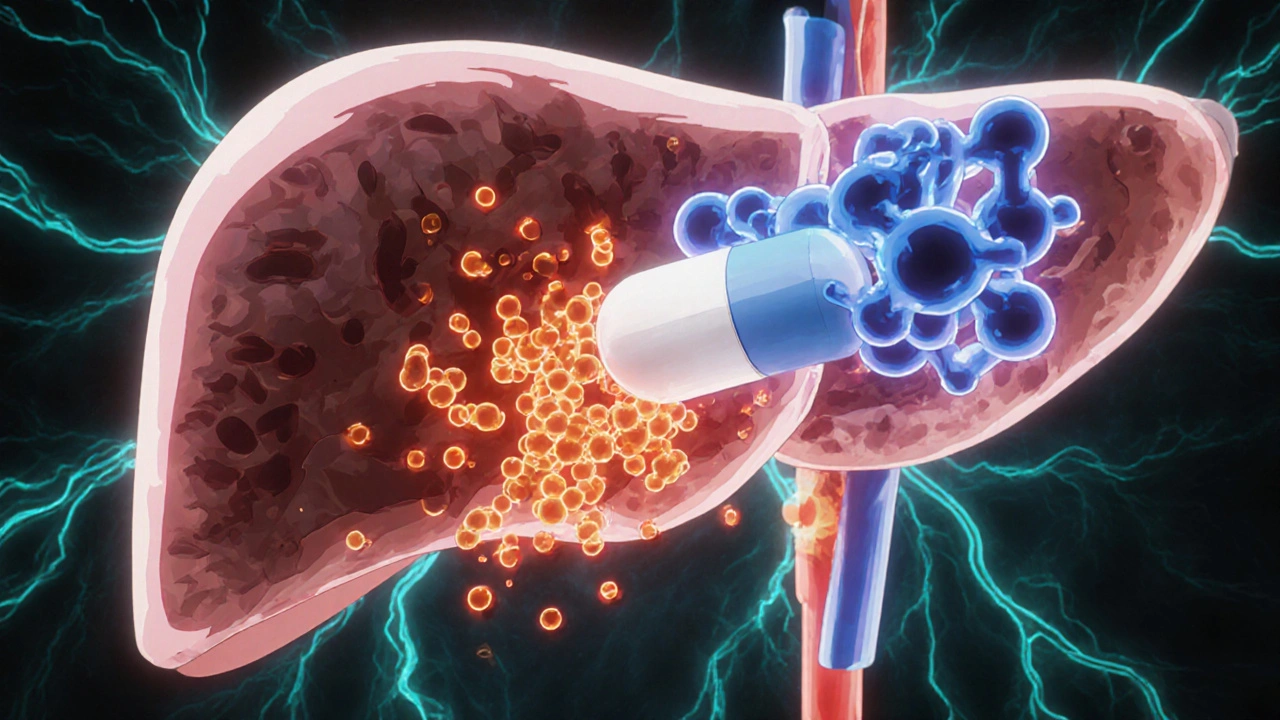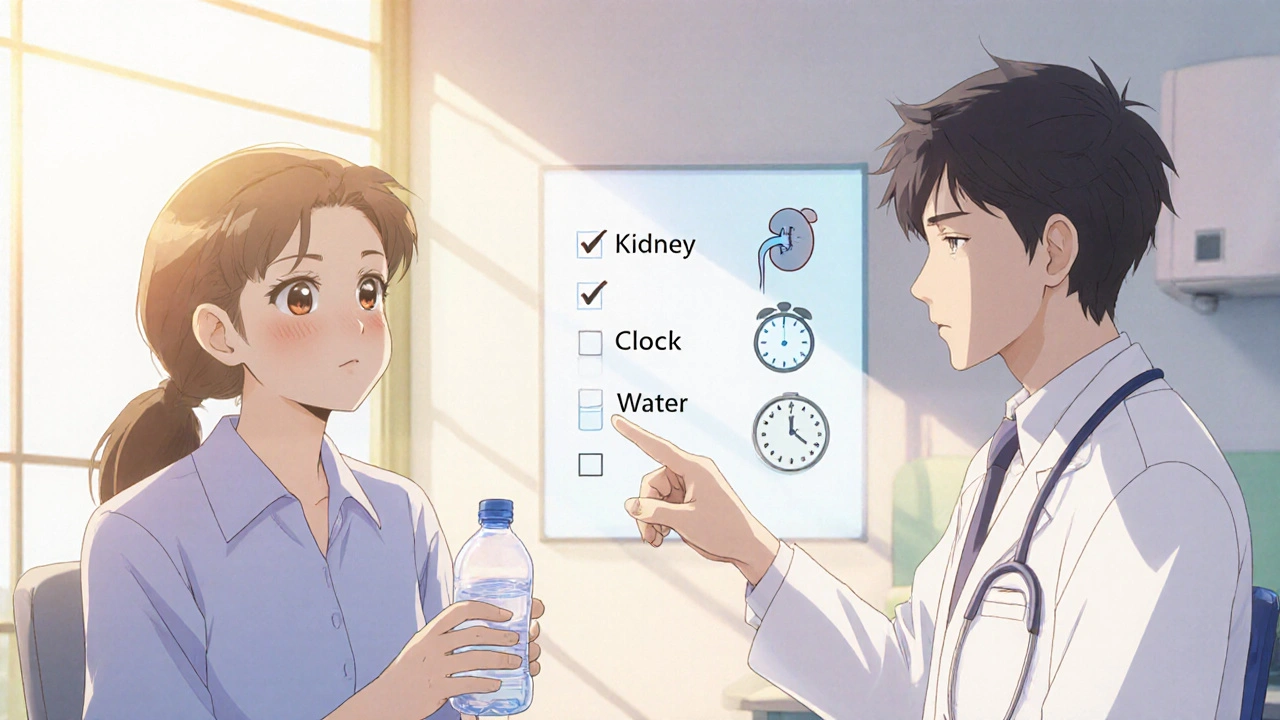Metformin + Alcohol Risk Calculator
Risk Assessment Tool
This tool helps you understand your risk of lactic acidosis when taking metformin and consuming alcohol. Based on kidney function and alcohol consumption patterns, it provides a risk level and guidance.
When you’re managing type 2 diabetes, the last thing you want to worry about is a life‑threatening emergency. Yet mixing metformin with alcohol can set the stage for lactic acidosis, a rare but deadly condition. This guide breaks down how the two substances interact, who’s most at risk, and what you can do right now to stay safe.
What is Metformin?
Metformin is a biguanide antihyperglycemic agent that reduces liver glucose production and improves insulin sensitivity. First approved by the FDA in 1995 under the brand name Glucophage, it quickly became the global first‑line therapy for type 2 diabetes because it lowers blood sugar without causing weight gain. About 150 million prescriptions are written each year in the United States alone, making it the most widely used oral diabetes drug.
How Alcohol Affects the Body
Alcohol is a central nervous system depressant metabolized primarily in the liver. During ethanol oxidation, NAD⁺ is converted to NADH, which slows the conversion of lactate back to pyruvate. This bottleneck reduces lactate clearance and can push blood lactate levels upward. When you binge drink, the liver’s capacity to process both ethanol and lactate is overwhelmed, creating a perfect storm for acid‑base imbalance.
Understanding Lactic Acidosis
Lactic Acidosis is a metabolic complication marked by blood lactate >5 mmol/L, pH <7.35, and an elevated anion gap. In the context of metformin, it’s called metformin‑associated lactic acidosis (MALA). Mortality rates range from 30‑50 % according to recent clinical reviews. The condition emerges when lactate production outpaces clearance, and the body can’t rebalance its pH quickly enough.
Why Metformin and Alcohol Together Raise the Stakes
Metformin works by inhibiting hepatic gluconeogenesis, a pathway that also generates lactate as a by‑product. Normally, kidneys clear about 90 % of metformin unchanged, and the liver removes lactate efficiently. Alcohol throws two wrenches into this system:
- Increased Lactate Production: Alcohol metabolism diverts NAD⁺, hampering the lactate‑to‑pyruvate conversion.
- Reduced Metformin Clearance: Dehydration and acute kidney stress from binge drinking can lower renal perfusion, raising metformin plasma levels above the 5 µg/mL safety threshold.
When both mechanisms act together, the net effect is a rapid rise in lactate with insufficient removal-a recipe for MALA even in patients with otherwise normal kidney function.

Who Is Most at Risk?
Data from FDA labeling and real‑world studies show an incidence of <10 cases per 100,000 patient‑years for MALA overall. Alcohol pushes that number higher:
- Renal Impairment: eGFR < 45 mL/min/1.73 m² multiplies risk dramatically.
- Heavy or Binge Drinking: >4 drinks (women) or >5 drinks (men) within 2 hours.
- Acute Illness: Dehydration, sepsis, or hypoxia can lower lactate clearance.
- Concurrent Medications: Drugs that further impair renal function (e.g., NSAIDs) add to the danger.
Even patients with normal kidneys have reported MALA after a night of excessive drinking, as documented in a 2024 case report of a 65‑year‑old man who consumed ten shots of spirits while on metformin.
How Common Is the Problem?
While metformin alone carries an estimated 0.03 cases of lactic acidosis per 1,000 patient‑years, the combination with alcohol can raise the risk several‑fold. A 2023 GoodRx survey found that 78 % of metformin users limit alcohol, and 42 % cite lactic acidosis as their main concern. The FDA’s black‑box warning explicitly states, “warn against excessive alcohol intake,” but does not define a safe threshold.
Comparing Diabetes Medications: Lactic Acidosis Risk
| Medication | Primary Mechanism | Lactic Acidosis Incidence (per 100,000 pt‑yrs) | Alcohol Interaction Warning |
|---|---|---|---|
| Metformin (IR/ER) | Inhibits hepatic gluconeogenesis | <5 | Black‑box warning - avoid excessive alcohol |
| Phenformin (withdrawn) | Biguanide, same pathway as metformin | 40‑64 | High risk - product removed |
| GLP‑1 Receptor Agonists (e.g., semaglutide) | Enhances insulin secretion, slows gastric emptying | ≈0 | No specific alcohol warning |
| SGLT2 Inhibitors (e.g., empagliflozin) | Increases urinary glucose excretion | ≈0 | Warns about dehydration, not lactic acidosis |
| Sulfonylureas (e.g., glipizide) | Stimulates pancreatic insulin release | ≈0 | Hypoglycemia risk with alcohol |
Metformin remains the only widely used oral agent with a measurable lactic acidosis signal, underscoring why its interaction with alcohol deserves close attention.

Practical Steps for Patients on Metformin
Because clear scientific thresholds are lacking, clinicians often rely on precautionary guidelines. Use this checklist to manage your risk:
- Know your renal function. Ask your doctor for the latest eGFR value before drinking.
- Avoid alcohol during the first 4‑8 weeks of therapy when dose titration occurs.
- If you choose to drink, stick to the American Heart Association’s moderate limits: ≤1 drink/day for women, ≤2 drinks/day for men.
- Never drink on an empty stomach; food slows alcohol absorption and reduces hypoglycemia risk.
- Stay hydrated. Dehydration raises metformin concentrations.
- Watch for early warning signs: sudden muscle pain, rapid breathing, nausea, vomiting, or a “hangover‑like” feeling that doesn’t improve.
- If any symptom appears, seek emergency care immediately; early treatment improves survival.
- Consider extended‑release formulations if gastrointestinal side effects are a problem; the lactic acidosis risk remains the same.
Recognizing and Responding to MALA
Time is critical. Typical laboratory findings in the ER include:
- Lactate > 5 mmol/L (often 6‑12 mmol/L in severe cases)
- pH < 7.35, anion gap > 12 mmol/L
- Metformin plasma level > 5 µg/mL (supports the diagnosis)
Treatment focuses on stopping metformin, correcting the acid‑base disturbance, and supporting renal function. Hemodialysis can rapidly clear metformin and is recommended when lactate exceeds 10 mmol/L or when renal failure is evident.
What the Latest Research Says
The ongoing MALA‑Prevention Study (NCT04892345) aims to pinpoint safe alcohol thresholds for metformin users. Preliminary data (expected late 2025) suggest that moderate intake may be tolerable for patients with eGFR ≥ 60 mL/min, but binge patterns still show a sharp rise in lactate levels. Meanwhile, experts like Dr. Silvio Inzucchi (Yale) call for evidence‑based guidelines, noting that current advice relies heavily on clinical judgement.
Bottom Line: Stay Informed, Stay Safe
Metformin saves millions of lives every year, but its interaction with alcohol is a real safety issue. By understanding the biology, recognizing risk factors, and following practical prevention steps, you can keep your diabetes under control without compromising your health.
Can I have a glass of wine while taking metformin?
A single glass (about 5 oz) is generally considered moderate and may be acceptable if you have normal kidney function and no history of binge drinking. Still, discuss it with your doctor, especially during the first weeks of therapy.
What are the early signs of metformin‑associated lactic acidosis?
Look for unexplained muscle cramps, rapid breathing, nausea, vomiting, or a lingering “hangover” feeling that doesn’t improve. If you notice any of these after drinking, seek medical help right away.
Does the extended‑release version of metformin reduce the risk of lactic acidosis?
The extended‑release formulation eases stomach upset but does not change the underlying risk of lactic acidosis. Alcohol avoidance guidelines are the same for both forms.
How does kidney function influence metformin safety?
Metformin is cleared unchanged by the kidneys. An eGFR below 45 mL/min/1.73 m² markedly raises plasma levels and, when combined with alcohol, dramatically increases the chance of lactic acidosis.
Is phenformin still used anywhere?
No. Phenformin was withdrawn in 1978 after it caused lactic acidosis in 40‑64 % of users. Its history highlights why metformin carries a much‑lower, but still present, risk.


Comments
Doreen Collins October 24, 2025 AT 17:42
If you’re on metformin, keep an eye on how much you drink. A single glass of wine is usually fine, but bingeing can tip you into trouble. Stay hydrated, know your kidney numbers, and talk to your doctor if you’re unsure.
Kester Strahan October 27, 2025 AT 16:55
The pharmacokinetic interplay between metformin and ethanol is all about the hepatic NADH/NAD+ shifttt. When you knock back booze, you raise NADH, which stalls lactate→pyruvate conversion. That bottleneck spikes lactate levels, especially if your eGFR is already borderline. So, if you’re on metformin, limit the binge sessions – keep it moderate or the risk of MALA goes up.
HILDA GONZALEZ SARAVIA October 30, 2025 AT 17:08
One thing to remember is that metformin’s safety profile hinges on kidney function. Even a healthy‑looking eGFR can dip temporarily after a night of heavy drinking, which means plasma metformin levels can climb. If you notice unexplained muscle cramps, rapid breathing, or that lingering hangover feeling, it might be your body signaling lactic acidosis. It’s not just about the amount of alcohol; the pattern matters-a single glass is different from a binge. Also, stay on top of regular labs; a simple creatinine check can save a lot of trouble later on.
Amanda Vallery November 2, 2025 AT 17:22
Metformin is cleared by the renel, so if u have low eGFR you should cut back on alchol. Even a smal amount can add up.
Dahmir Dennis November 5, 2025 AT 17:35
Ah, the age‑old dilemma of sipping a cocktail while taking a medication that supposedly saves millions of lives. Let’s be clear: metformin isn’t the villain here; it’s the reckless combination of excessive booze and a drug that lives in your bloodstream waiting for the perfect storm. When you drink heavily, your liver’s ability to process both ethanol and lactate sputters, and suddenly the modest lactate that your muscles produce in a normal workout becomes a ticking time bomb. Add a compromised kidney, and you’ve got metformin accumulating like an unwelcome guest at a party that just won’t leave. The paradox is that many patients think a single glass won’t hurt, yet the data shows that even moderate intake can push lactate levels into the danger zone for those with borderline renal function. This isn’t a myth concocted by pharmaceutical marketing teams; it’s backed by case reports, the FDA’s black‑box warning, and real‑world surveys where nearly half of metformin users admit to limiting alcohol out of fear. If you’re the type who enjoys a weekend binge, you’re practically inviting lactic acidosis to the table, and let’s face it, nobody wants an emergency room visit because of a party. On the flip side, if you’re disciplined and keep your intake under the recommended limits-say, a glass of wine with dinner-your risk remains low, provided your kidneys are functioning well. The key takeaway is simple: know your numbers, respect the guidelines, and don’t treat metformin like a casual party favor. Otherwise, you might find yourself battling a metabolic crisis that could have been avoided with a little common sense.
Dawn Bengel November 8, 2025 AT 17:48
🇺🇸 As proud Americans, we should prioritize our health over a cheap beer. Mixing metformin with booze is a recipe for disaster, and anyone who thinks otherwise is just ignoring the science. Stay safe, stay strong! 🍷🚫
junior garcia November 11, 2025 AT 18:02
This is a crucial reminder for anyone on metformin.
Dason Avery November 14, 2025 AT 18:15
Remember, taking care of yourself is the first step toward a brighter future. Even a modest drink can shift the balance, so stay mindful and keep the conversation open with your healthcare team. 😊
Casey Morris November 17, 2025 AT 18:28
Indeed-one must consider the biochemical ramifications; however, it is equally vital to maintain a balanced lifestyle, especially when dealing with chronic conditions. A measured approach to alcohol consumption, coupled with regular monitoring of renal function, can mitigate undue risk. Nevertheless, each patient’s context is unique, and personalized guidance remains paramount.
Teya Arisa November 20, 2025 AT 18:42
Dear community, it is advisable to adhere to moderate alcohol intake while on metformin, ensuring continuous dialogue with your physician to safeguard renal health. Please feel free to share your experiences, as mutual support strengthens our collective well‑being. 😊